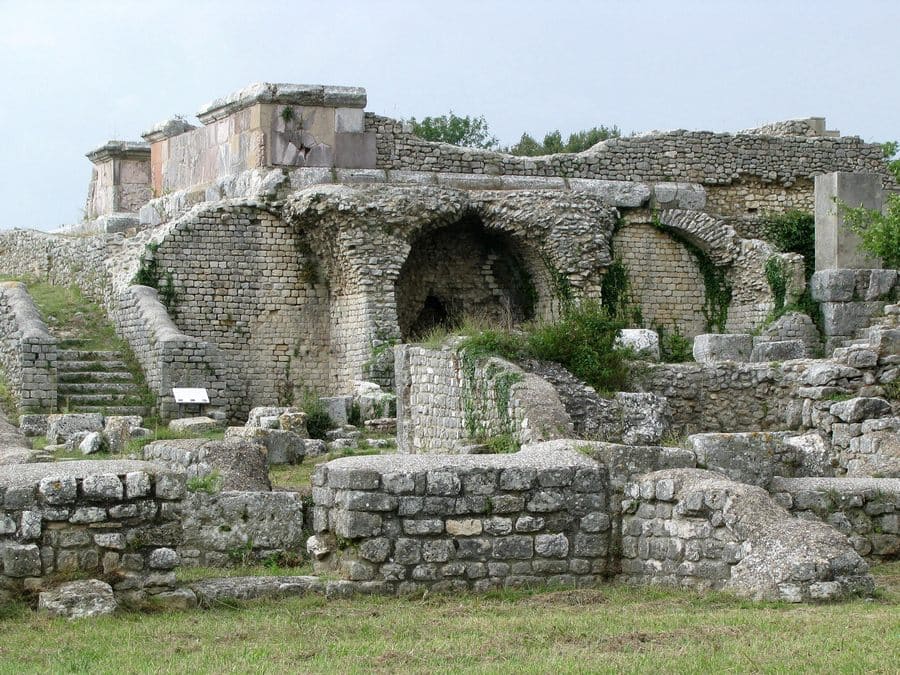On the footsteps of Romans in the surrounding of San Gemini
The village of San Gemini is located in an area considered very strategic during the Roman Empire and interesting traces of that glorious period are still well-preserved and can be visited.
So, if you are passionate about Roman history or only curious to better know this important historical period, a break in San Gemini can be a perfect opportunity to discover the traces of the Romans in Umbria.
Read which are the main Roman sites in the surroundings of San Gemini:
The Archaeological Park of Carsulae, Terni
The Archaeological Park of Carsulae is located along the Via Flaminia, an important road that connected Rome to the Adriatic Sea and to the Northern Italy, a few kilometres from San Gemini and Terni.
During a visit to this large archaeological park that covers an area of about 20 hectares, it is possible to admire the remains of the ancient village of Carsulae, whose history is still partly shrouded in mystery.
The edification of this village probably dates back to 900 BC, the Roman period coincided with its strong development but during Middle Ages, it registered a progressive decline and abandonment, perhaps favoured by a tremendous earthquake or other natural disasters that almost completely destroyed it.
Today, while walking through the Archaeological Park of Carsulae, it’s possible to admire the Arch of San Damiano, the amphitheatre, the Gemini Temple, the forum, some private houses and various funerary monuments.
- Useful information: the Archaeological Park of Carsulae is open from the last Sunday of March to the last Saturday of October from 8.30am – 7.30pm, from the last Sunday of October to the last Saturday of March from 8.30am – 5.30pm.

Archaeological Park of Otricoli
The Archaeological Park of Otricoli is located a few kilometres from Terni, near a beautiful hill on top of which stands the ancient town of Otricoli dominated by a marvellous castle.
In this archaeological park, already known and visited since the Nineteenth century, there is a forum, a theatre, an amphitheatre, various private houses, and funerary monuments.
To complete your walk through history, it is also recommended a visit to the Antiquarium Casale S. Fulgenzio a structure inside the park that hosts numerous archaeological finds dating back even to the pre-Roman era.
- Useful information: during the summer the Archeological Park of Otricoli hosts exciting historical re-enactments to which you can attend paying a ticket, otherwise access is free. During the historical re-enactments, the Euro coins are changed in Sesterzi.
The Fausto Amphitheatre, Terni
Terni is set in a wide plain at the confluence of the Senna and Nera rivers, in the south-eastern Umbria.
The origins of this town are ancient, even dating back to the Iron Age and this area is rich in important archaeological finds.
In the long history of Terni, however, stands out the Roman period during which this town prospered and flourished thanks to the intense trade with Rome.
The majestic Fausto Amphitheatre dates back to 1st century AD, during the Roman era. This amphitheatre is, in fact, more ancient than the Colosseum in Rome but has a smaller capacity, “only” 10,000 spectators against 45,000-50,000 that can accommodate the structure of the Eternal City.
The view of the Fausto Amphitheater is made even more suggestive by its special geographical location in the historic centre of Terni between the Cathedral and the Church of Carmine.
- Useful information: the Flavio Amphitheater can only be visited from the outside, as access is allowed only during the many events that take place in summer.

The Roman Shipyard of Stifone, Narni
Following the footsteps of Romans around San Gemini, a visit to the Shipyard of Stifone near Narni is unmissable. This evocative place where nature and history blend in a unique and exciting mix was discovered only in 1969. Until then, in fact, nature has hidden this little gem that testifies the incredible genius of the Romans and the liveliness of commercial relations between Umbria and Rome.
This shipyard is located in an artificial canal next to the Nera river close to the ancient port of Narnia, preserved only in part. The Shipyard of Stifone is surrounded by a series of walls with large holes where boats were fixed. A visit to this charming place is also recommended to admire the wild nature that surrounds it.
- Useful information: if you love ancient villages, the advice is to visit Stifone, very near to the Shipyard.
The Roman Cisterns, Amelia
Amelia is a small town located a few kilometres from Terni with very ancient origins, witnessed by megalithic walls dating back to the VII century BC. During the Roman era, Amelia experienced a period of considerable expansion as witnessed by its Roman Cisterns built between the 2nd and the 1st century BC under the Roman forum that today corresponds to Piazza Matteotti.
This ingenious civil work comprises 10 environments of similar size and it is amazing their perfect state of conservation. A thousand years after their construction, the Roman Cisterns are still fully functional. The care with which Romans built their infrastructures was incredible! Visiting the Roman Cisterns means, also, to live an exciting underground journey to discover the world of the ancient Romans and their incredible abilities.
- Useful information: although the rooms of the Roman tanks are large, this visit is not recommended for those suffering from claustrophobia. To access the underground you need to pay for the ticket.

